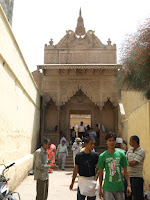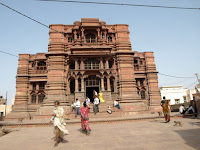Vrindavan – The place of transcendental bliss
Vrindavan (alternately spelled Vrindaban, Brindavan, Brindavana, or Brundavan) also known as Vraj (as it lies in the Braj region) is a town in the Mathura district of Uttar Pradesh, India. It is the site of an ancient forest which is the region where Lord Krishna spent his childhood days.
The town is about 15 km away from Mathura, the city of Lord Krishna's birthplace, near the Agra-Delhi highway. The town hosts hundreds of temples dedicated to the worship of Radha and Krishna and is considered sacred by a number of religious traditions such as Gaudiya Vaishnavism, Vaishnavism, and Hinduism in general.
The ancient name of the city, Brindavana, comes from its groves of 'Brinda' Ocimum tenuiflorum (Holy Basil or Tulsi) with vana meaning a grove or a forest. Two small groves still exist at Nidhivan and Seva Kunj.
Vrindavan was the place where Lord Krishna spend his childhood and teenage enjoying the earthly mischiefs and pranks. This is the place where Lord Krishna shown the eternal love with the Gopi’s especially Radha ji. A devotee who enters Vrindavan can literally feel the vibrations of love and affection of Lord Krishna and his Gopi’s. The places where Lord Krishna wandered along with his friends and Gopi’s will definitely reverberate in your antharatma (subconscious mind) and takes you in a journey of transcendental bliss.
History
Vrindavan has an ancient past, associated with Hindu history, and is an important Hindu pilgrimage site. One of its oldest surviving temples is the Govinda Deo temple, built in 1590, with the town founded earlier in the same century.
It is believed that the essence of Vrindavan was lost over time until the 16th century, when it was rediscovered by Lord Chaitanya Mahaprabhu. In the year 1515, Lord Chaitanya Mahaprabhu visited Vrindavan, with purpose of locating the lost holy places associated with Lord Sri Krishna's transcendent pastimes. Lord Chaitanya wandered through the different sacred forests of Vrindavan in a spiritual trance of divine love. By His divine spiritual power, He was able locate all the important places of Lord Krishna's pastimes in and around Vrindavan.
Legends
Vrindavan is considered to be a holy place by all traditions of Hinduism. The major tradition followed in the area is Vaishnavism, and it is a center of learning with many Vrindavan Ashrams operating. It’s a center of Krishna worship and the area includes places like Govardhan and Gokul that are associated with Krishna. Many millions of devotees of Radha Krishna visit these places of pilgrimage every year and participate in a number of festivals that relate to the scenes from Krishna's life on Earth.
According to tradition and recorded evidence, Krishna was raised in the cow herding village of Gokul by his foster parents Nanda Maharaj and Yasoda. The Bhagavata Purana describes Krishna's early childhood pastimes in the Vrindavan forest where he, his brother Balaram, and his cowherd friends stole butter, engaged in childhood pranks and fought with demons. Along with these activities, Krishna is also described as meeting and dancing with the local girls of Vrindavan village, especially Radharani, who were known as Gopis. These pastimes were the source of inspiration for the famous Sanskrit poem, Gita Govinda, by the Sanskrit poet, Jayadeva (1200 AD).
It is said that because of the blessings of Lord Krishna, Kalyug will not enter Vrindavan.
Madan Mohan Temple
Madan Mohan Temple located near the Kali Ghat was built by Kapur Ram Das of Multan. This is the oldest temple in Vrindavan. The temple is closely associated with Shri Chaitanya Mahaprabhu. The original image of Lord Madan Gopal was shifted from the shrine to Karauli in Rajasthan for safe keeping during Aurangzeb's rule. Today, a replica of the image is worshiped at the temple.
Banke Bihari Temple
 |
| Entrance of Nidhivan, Vrindavan, Mathura, Uttar Pradesh, India |
Banke Bihari Temple, built in 1862 is the most popular shrine at Vrindavan. The image of Banke-Bihari was discovered in Nidhi Van by Swami Haridas, the great Krishna devotee, belonging to the Nimbarka sampradaya.
Radha Vallabh Temple
Radha Vallabh Temple, set up by the Radha-Vallabh sampradaya, through Sri Hith Harivansh Mahaprabhu, has the crown of Radharani placed next to the Shri Krishna image in the sanctum sanctorum.
Shri Radha Madhava Temple
 |
| Radha Madhav temple, Vrindavan, Mathura, Uttar Pradesh, India |
Jaipur Temple which was built by Sawai Madho Singh II, the Maharaja of Jaipur in 1917, is a richly embellished and opulent temple. The fine hand - carved sandstone is of unparalleled workmanship. The temple is dedicated to Shri Radha Madhava.
Sri Radha Raman Mandir
Sri Radha Raman Mandir, constructed at the request of Gopala Bhatta Goswami around 1542 is one most exquisitely crafted and revered temples of Vrindavan, especially by the Goswamis. It still houses the original saligram deity of Krishna, alongside Radharani.
Shahji Temple
 |
| Shahji temple, Vrindavan, Mathura, Uttar Pradesh, India |
Shahji Temple, another popular temple at Vrindavan, was designed and built in 1876 by a wealthy jeweller, Shah Kundan Lal of Lucknow. The deities (images) at the temple are popularly known as the Chhote Radha Raman. Noted for its magnificent architecture and beautiful marble sculpture, the temple has twelve spiral columns each 15 feet high. The `Basanti Kamra' - the durbar hall is famed for its Belgian glass chandeliers and fine paintings.
Rangaji Temple
 |
| Rangaji Temple, Vrindavan, Mathura, Uttar Pradesh, India |
 |
| Rangaji Temple, Vrindavan, Mathura, Uttar Pradesh, India |
 |
| Rangaji Temple, Vrindavan, Mathura, Uttar Pradesh, India |
 |
| Rangaji Temple, Vrindavan, Mathura, Uttar Pradesh, India |
 |
| Rangaji Temple, Vrindavan, Mathura, Uttar Pradesh, India |
Rangaji Temple, built in 1851 is dedicated to Lord Ranganatha or Rangaji depicted as Lord Vishnu in his Sheshashayi pose, resting on the coils of the sacred Sesha Naga. The temple built in the Dravidian style (as a replica of Srivilliputhur) has a tall gopuram (gateway), of six storeys and a gold - plated Dhwaja stambha, 50 feet high. A water tank and a picturesque garden lie within the temple enclosure. The annual festival of Jal Vihar of the presiding deity is performed with great pomp and splendor at the tank. The temple is also famous for its `Brahmotsdav' celebration in March–April, more popularly known as the `Rath ka Mela'. The ten day long celebrations are marked by the pulling of the rath (the chariot car) by the devotees from the temple to the adjoining gardens. The prayers within the temple are performed, following in the style of Andal, one of the twelve Vaishnav Saints of South India.
Govind Deo (Govindaji) Temple
Govind Deo (Govindaji) Temple was once a magnificent seven storeyed structure built in the form of a Greek cross. It is said that the Emperor Akbar donated some of the red sandstone that had been brought for the Red Fort at Agra, for the construction of this temple. Built at the astronomical cost of one crore rupees in 1590 by his general Raja Man Singh, the temple combines western, Hindu and Muslim architectural elements in its structure. It was destroyed by Mughal ruler Aurangzeb.
Sri Krishna-Balaram Temple
Sri Krishna-Balaram Temple built by the International Society for Krishna Consciousness (ISKCON) in a location known as 'Raman-Reti', is one of the most beautiful temples in Vrindavan today. The principal deities of this temple are Krishna & Balaram, with Radha-Shyamasundar and Gaura-Nitai alongside. Adjoining the temple is the Samadhi of A. C. Bhakti Vedanta Swami Prabhupada, the founder of ISKCON, built in pure white marble.
Radha Damodar Mandir
Radha Damodar Mandir Located at Seva Kunj, the Mandir was established in 1542 by Srila Jiva Goswami. The deities Sri Sri Radha Damodar are here. The bhajan kutir of A. C. Bhakti Vedanta Swami Prabhupada is also situated at the Mandir.
Shri Maa Katyayani Mandir
Shri Maa Katyayani Mandir, the temple is situated in Radha Bagh, near Rangnath mandir. This is one of suddh Shakti Peetha of Shakti.
Chintaharan Hanuman Mandir
Chintaharan Hanuman Mandir, temple of Lord Hanuman is situated near Atalvan.
Shree Radha Ras Bihari Ashta Sakhi Temple
In Vrindavan, the “Lila Sthan” (the place of the divine Passion play) of Lord Krishna, lies the temple that is a must visit destination for devotees completing the 84 kosh Vraj Parikrama Yatra. The temple is centuries old and is the first Indian temple that is dedicated to the divine couple and their Ashta Sakhi’s - the eight “companions” of Radha who were intimately involved in her love play with the Lord Krishna. The Ashta Sakhis are mentioned in the ancient texts of Puranas and the Bhagavata Purana. The temple is called Shree Radha Ras Bihari Ashta Sakhi Mandir and it is home to the divine Rasa Lila of Lord Krishna and Radharani. It is located in close proximity to the Shri Banke Bihari Mandir. Legend has it that the Shree Radha Rasa Bihari Ashta Sakhi Mandir is one of the two places in Mathura, Vrindavan where the Lord Krishna actually indulges in the Rasa Lila with his beloved Radha and her sakhis. On these nights, devotees have reported hearing the sound of the anklets, beating in tune to a divine melody.
Here are my inspirations
 |
| Prachetas Nair, Pranav Nair |
 |
| Prachetas Nair, Pranav Nair |
Friends
Hope you are enjoying my postings. Please post your comments to help me to improve my skills. Anybody who would like to visit these place, if any guidance required please feel free to contact me.
Let me sign off for the time being
Yours Friendly
Premaanand